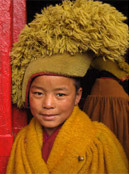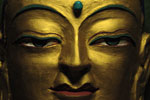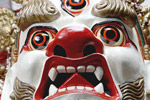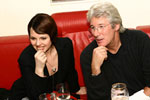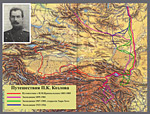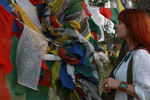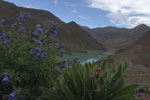Tibet House in Moscow released the Russian Edition about Panchen Lama lineage
Today, the 25th of April 2016, is the twenty-seventh birthday of Gedhun Choekyi Nyima, the 11th Panchen Lama. But can the followers of Buddhism call this day a holiday? It is quite a complicated question and if go into it at large, we’ll see a challenge to the whole system of traditional Tibetan Buddhism. Rejecting the proposals of Tenzin Gyatso, the 14th Dalai Lama, on the joint search for the 11th Panchen Lama and later contesting legitimacy of His choice of Gedhun Choekyi Nyima as reincarnation, the Chinese government has broken with its own hands the age-old concepts of the institute of continuity and search for reincarnation, losing forever the thread of mutual dialogue with Tibetan Buddhists. And annual legislative innovations relating the Tibetan clergy only make this gap wider.
We know that it is impossible to win or buy faith and respect of the Tibetans through different titles; the basis of their religious feelings is to follow the ancient tradition of Buddhist philosophy and moral behavior as a part thereof. By forcing the Tibetans to follow spiritual leaders “appointed by the Party”, China plays a losing game escalating conflict and opposition against drastic interference. In sixty years after occupation of Tibet, one can make a judgment on the result of “ideological re-education” of indigenous people living in the Land of Snows: it is pain and disappointment.
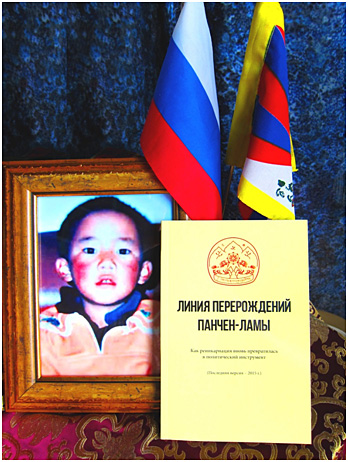
The Tibetans will never become the Chinese; this is contrary to common sense and confirmed by the world historical examples. However, the Chinese government aggravates the problem by increasing military presence and conducting barbarous colonial policy towards the Tibetans and the Tibetan Plateau resources instead of looking for an effective solution of the problem and allowing the Tibetans to live with dignity on their homeland. So, the issue on choice of the Panchen Lama is now not a purely religious one but it reveals a number of serious problems which can be solved only by means of equal and ideologically neutral dialogue with the Tibetans.
At present, the fate of Gedhun Choekyi Nyima missing at the age of six is the most important thing. It is necessary to put the dispute over religious legitimacy aside and reveal true information on well-being of the young Tibetan and his family.
With publication of the Russian version of the book “The Panchen Lama Lineage: How Reincarnation is Being Reinvented as a Political Tool” issued by the Department of Information and International Relations of the Tibetan Central Administration in December 2015, we call upon to pay attention to a series of unprecedented events relating to tragic fate of the Tibetan people and disappearance of a person whose life is a priori defined by both the law of the People's Republic of China, the international law and humanitarian standards of civilization.
In view of the Russian long-standing historical and spiritual ties* with the Panchen Lama lineage and the 250th anniversary of Buddhism in Russia, the present press-release is added with information on relations of Russia with Tibet especially with the Panchen Lamas of Tibetan Buddhism.
Nadya Berkengeym,
Vice President
Tibet House in Moscow
April 24, 2016
* - “... Catherine the Great was the first Russian monarch who took an interest in far-off Tibet. In 1767 or 1768 the Empress asked Pandito Khambo Lama I Zayaev (who arrived in Moscow together with the representatives of other confessions to take part in development of new religious laws) to tell about his travel to Tibet. Zayaev’s story produced a great impression on the Empress and she recommended Khambo Lama to write about his travels and he did it in Buryat and Tibetan languages.
The Empress conferred benefits upon Zayaev: he received “the charter with white seal certifying his high title as Khambo Lama”, the Order of St. Andrew with the right to wear it around the neck “for advancement of religion in accordance with the laws of the Russian state”, and the annual salary at the rate of 50 Rubles. All this gave cause for the Buryat lamas to speak that Buddhism was under the auspices of the Russian Empress and even declare her as an earthly incarnation of White Tara, the Goddess of Mercy.
There is evidence that Catherine II, probably influenced by the story of Khambo Lama I Zayaev, tried to enter into relations with the Panchen Lama, the highest ranking lama after the Dalai Lama, a ruler of Tibet, whose residence was at Tashilhumpo monastery in the south of the country (Tsang province). This was reported in 1783 by Captain Samuel Turner, the Head of the British Embassy in the Court of Panchen Lama IV, who made reference to two senior Tibetans: the regent of the minor Panchen Lama and his cupbearer Sopyon Khambo. According to Turner, Russia (under Catherine II) «made several attempts to expand its trade inside Tibet but reluctance of the Tibetans to enter into relations with new foreign states as well as jealous vigilance of the Chinese prevented implementation of such intentions up until now”.
Besides, the regent told the Englishman that some years ago (i.e. at the end of the 1770s) the Empress, wishing to enter into relations with Taranatha Lama (the Khutukhta of Urga), sent the ambassadors to him together with the letter and rich gifts. “I saw the illustrated Bible in Russian among these gifts,” - Turner wrote. Taranatha Lama revering the Panchen Lama as the guardian of Mongolia and oracle of Lama hierarchy, forwarded him these gifts together with a letter of the Empress and asked his advice on this important issue.
The Panchen Lama reacted to proposals of the Russians without enthusiasm but gave his consent to some limited relations as a result of which the Russian traders started from time to time came to Khalkha, the residence of Taranatha Lama, where they carry on substantial trade through their agents up until now. There is an interesting fact in Turner’s report that Catherine II wishing to establish trade relations with Tibet addressed not to the Dalai Lama, the supreme ruler of the country, but to the Panchen Lama.
The Panchen Lama also seemed to show an interest in Russia and its rulers. As early as in 1775, accepting George Bogle, the Head of the first British Embassy in Tibet, the Panchen Lama III asked him, among the other things, about Russia and relationship between the English king and the Russian Empress (Catherine II).
G.Bogle replied that the British Monarch “has more influence at the Russian court than any other ruler in Europe” and the Panchen Lama said with joy that in case of war between Russia and China, He will certainly (“with the help” of the East India Company) “do something to restore peace” because therein lies His “Lama’s mission”.
The above facts allow suggesting that at the end of the 18th century one of two ruling elites in Tibet (the Panchen Lamas) had a very definite idea of Russia as a powerful state of the Russian tsars actively carrying on trade with Mongolia and China mostly through Buddhist pilgrims and traders - Mongols, Kalmyks and Buryats. And probably, the rulers of Lhasa, the Dalai Lamas, controlling the most part of the central Tibet, had similar information.
Under the reign of Catherine II, there were the first publications on Tibet and Buddhism was recognized as one of the state religions in the Russian Empire. Thus, in 1779 “Academic News” published “Modern and True Description of the Tibetan State” written by Stuart, an Englishman, translated into Russian by Karl Bogdanovich and reprinted from the publication of the Royal Scientific Society.
In fact, it was a story about George Bogle’s mission to the Panchen Lama which contained interesting information about Tibet. At the same time the Russian reader could not but be flattered with the fact stated by Stewart that the Russian empire was the only European country known to the Panchen Lama: “He had quite a clear idea about wealth and power of Russia, he heard about the latest Russian war and great military success of the Russian weapon in the fight against the Ottoman state but he did not imagine that Russia was so vast in reality. Many Tatars, the Russian subjects, come to Tibet”. According to Stuart, “at different times the Emperor Peter the Great sent the charter and gifts to Lama” (the Panchen Lama) – this is another fact not recorded in the annals of the Russian history”.
* Based on materials from
A.I. Andreev’s book “Tibet in Tsarist, Soviet and Post-Soviet Policy”.
The event dedicated to 27th birthday of the Panchen Lama
The event dedicated to 27th birthday of the Panchen Lama will be held on Monday, April 25 in the Sakharov Center on Zemlyanoy val, d.57, 6 bl (main building, hall on the second floor). Directions to the metro station "Kurskaya Ring" or "Chkalovskaya"; "Taganskaya".
Beginning at 19:00.
All guests will get a book as a gift.
Free admission.
Organizers:
“Center of Tibetan Culture and Information”, "Save Tibet Fund”, "Tibet House in Moscow".
![]()
![]()
![]()
![]()
